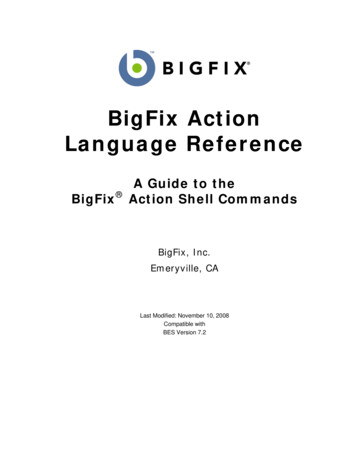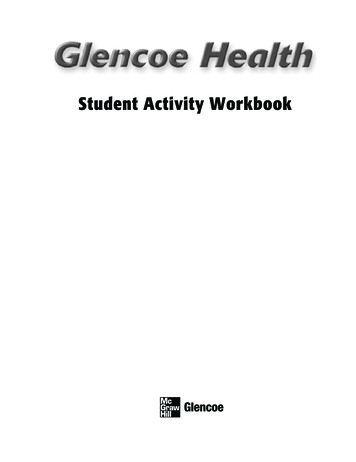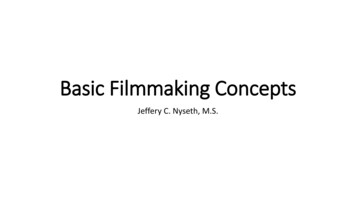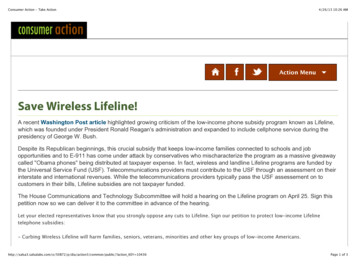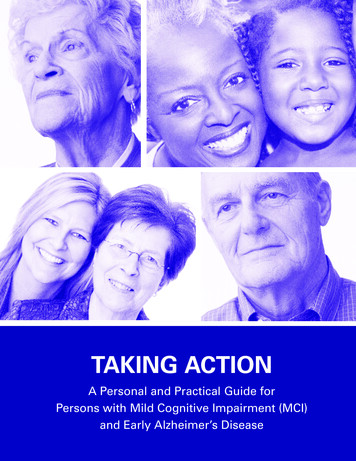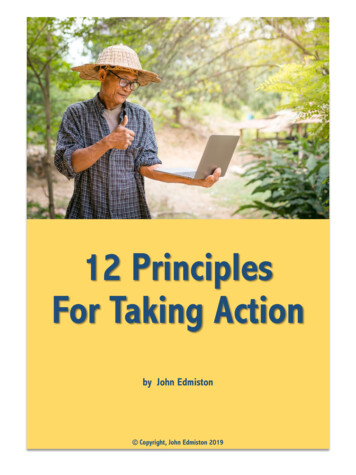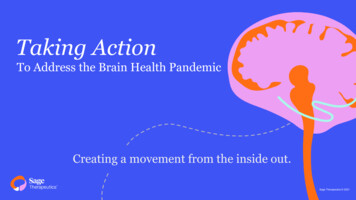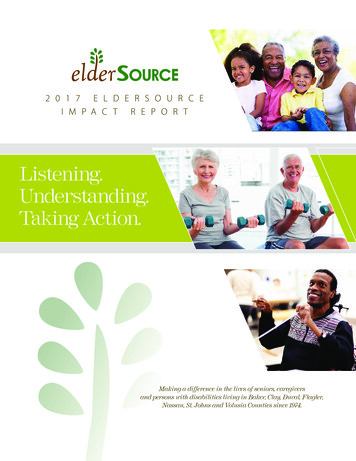
Transcription
TAKING ACTION TAKINGTAKINGACTIONACTIONTAKING ACTION TAKINGTAKINGACTIONACTIONTAKING ACTIONTAKING ACTIONTAKING ACTIONTAKING ACTION TAKINGTAKINGACTIONACTIONTAKING ACTION TAKINGTAKINGACTIONACTIONTAKING ACTION TAKINGTAKINGACTIONACTIONTAKING ACTION TAKINGTAKINGACTIONACTIONPositioningLow-Income Workersto Succeed in aChanging Economy
C ONTENTSA B O U T T H I S R E P O RT1I N T RO D U CT I O N2Responding to a Changing Economy:Promising Approaches to Advance Workplace EquityAllison Gerber / Sameer Gadkaree2E D U CAT I O N A N D S K I L L S4Introduction to Education and Skills4All One System: The Future of Education and Career PreparationAnthony P. Carnevale / Tanya I. Garcia / Kathryn Peltier Campbell6An Unequal Future of Work Requires Different Training Strategiesfor Vulnerable WorkersAndy Van Kleunen / Molly Bashay / Spencer Overton / Harin Contractor15CASE STUDIESChallenging the Traditional Higher Education Model:College for America at Southern New Hampshire UniversityBrian Flemingiii21Building New Partnerships to Address the Skill and Equity GapsJake Schwartz / Plinio Ayala27Building Skills and Social Capital in New Orleans’ Design WorldBrice White33Makerspaces and the Future of WorkWill Holman39TAKING ACTION: Positioning Low-Income Workers to Succeed in a Changing Economy
Using Technology to Help Low-Wage Workers Advance in Silicon ValleyChristian Valdez44Changing Tides: The Future of Jobs in Maine’s Marine EconomyHugh Cowperthwaite / Cynthia Murphy50WO R K E R AG E N CY56Introduction to Worker Agency56Worker Agency: Creating a Brighter Future of WorkCarmen Rojas57CASE STUDIESSilicon Valley Rising: Organizing to Build an Inclusive Tech EconomyMaria Noel Fernandez61Carina Care: Using Technology to Empower Home Health Care AidesRebecca von Loewenfeldt / Abby Solomon67The Original Gig Workers: Securing Benefits for Domestic WorkersPalak Shah73The Future of Human Rights Protection in Corporate Supply ChainsSean Sellers78P O L I CY83Introduction to State and Local Policies83The Future of Work: State and Local PoliciesRebecca Smith84CASE STUDIESMissouri’s Fight for 15: A Long-Term Campaignto Secure Dignity for WorkersRichard von Glahn / Caitlyn AdamsPassing and Implementing Secure Scheduling in SeattleDaniel Schneider / Kristen HarknettivTAKING ACTION: Positioning Low-Income Workers to Succeed in a Changing Economy9298
About this ReportThis report aims to shift the discussion about the changing nature of work from analysis and into action by showcasing strategies, policies and programs that already areimproving the present and future for lower-wage workers and their families.Though funded by the Annie E. Casey Foundation and the Joyce Foundation, the findingsand conclusions presented here are those of the authors alone.Loh-Sze Leung of Leung Consulting and Nancy Snyder of Nancy Snyder Consultingoversaw the project and provided significant input and guidance along the way. Indeveloping this report, they interviewed a number of experts in the field and would liketo thank all of them for generously sharing their time and insights. To select the featured case studies, the project directors issued an open call for submissions, revieweda wide range of proposals and worked with foundation staff to select a diverse set ofsolutions and approaches to feature. The project directors would also like to thankall of the authors for their compelling case studies and framing pieces and for beingthoughtful partners in producing this report. Finally, the project directors thank thefoundations for their support but accept responsibility for all errors and omissions.This report was compiled, edited and designed by The Hatcher Group.1TAKING ACTION: Positioning Low-Income Workers to Succeed in a Changing Economy
IntroductionResponding to a Changing Economy:Promising Approaches to AdvanceWorkplace EquityWith income, wealth and racial inequalities on the rise, the Annie E. Casey and Joycefoundations seek to understand what it would take to ensure that the next generationof workers—whom we know are increasingly diverse—have the opportunities theyneed to succeed in the face of a changing economy.Unlike past decades, stable jobs and good wages today almost always require a postsecondary education. Those that do not, usually come with a price: greater instabilityand tenuous employment conditions.These burdens disproportionately impact those already struggling to get by—includingAfrican American and Latinx workers who are overrepresented in entry-level, low-wagejobs. We must act—as some of the authors in this publication have—to ensure theseracial inequities do not widen further.Our goal in supporting this publication was to understand what people are alreadydoing to address these weighty problems. After all, many of the best solutions stemfrom the everyday work being done by individuals in states, cities and nonprofits.2TAKING ACTION: Positioning Low-Income Workers to Succeed in a Changing Economy
There are bright spots across the country that we wanted to shine a light on: a programin California that uses mobile technology to help janitors improve their English; an effortin Maine that helps fishermen transition to aquaculture; a national digital platformthat allows house cleaners to access paid time off and insurance; and a makerspacein Baltimore supporting local entrepreneurs.These and other case studies are organized into three types of strategies, thoughmany could fit in more than one:1.strategies that higher education and workforce leaders are using to prepareyoung people for jobs that increasingly require postsecondary education to earnfamily-sustaining wages;2. responses from the field to long-standing, and perhaps intensifying, worries aboutworker power and agency at a time when gig and contract work appear to berising; and3. state and local policies that political leaders have enacted to address wages,work and our changing economic context.But we acknowledge small-scale, innovative efforts will not be sufficient.The labor market and education systems, including higher education, remain besetby severe race- and income-based inequities. Racial disparities in wealth buildingalso have widened over the past three decades, as have race- and wealth-based gapsin college attainment. At the same time, there are deep ideological divides betweenpolitical leaders across the country and, at times, their constituents, regarding therole of government in addressing these challenges. Leaders in Seattle, for example,adopted a policy to create more predictable work schedules despite objections frombusiness associations, while a minimum wage battle in Missouri shows how statepre-emption laws may presage strife between city and state leaders in the years ahead.While much work lies ahead to address our changing world, we hope you will find thesestories as inspiring and thought-provoking as we do.Allison GerberThe Annie E. Casey Foundation3Sameer GadkareeThe Joyce FoundationTAKING ACTION: Positioning Low-Income Workers to Succeed in a Changing Economy
Educationand SkillsIntroduction to Education and SkillsOver the past several decades, we have seen a gradual increase in the level of education needed to make a family-sustaining wage—with a gradual erosion of jobs that paygood wages and offer stable employment but require little or no education beyond ahigh school diploma.Automation and artificial intelligence are driving some of these shifts in occupations,industries and skills that are in demand. Educational credentials and degrees, and theskills they represent, appear to be a key differentiator between those who can thrive inthe economy of the future and those who cannot. Unfortunately, existing educationalsystems are beset by racial and family wealth-based inequalities; higher education inparticular has seen widening disparities in recent decades.We need both policy solutions and new programmatic approaches to skill and credential attainment that create greater access to and completion of post-secondaryeducation, especially for people of color and low-income families and youth; respond4TAKING ACTION: Positioning Low-Income Workers to Succeed in a Changing Economy
to the need for flexible, lifelong learning; and address the skills that workers of thefuture will need, including: a strong foundation of higher order literacy, numeracy and digital skills that enablecritical thinking and creativity;social and emotional skills that facilitate work in a complex environment usingcommunication, collaboration and self-management skills,the ability to know what you need to learn and how to access that learning andrepeat that dynamic over a lifetime.What needs to change about our education systems and policies in order to closedisparities? What skills are/are not going to be in demand in the evolving labormarket? What type of programs or approaches will work to help individuals acquirethose skills? How do workforce and education programs need to evolve to help moreindividuals attain these skills? The authors in the section ahead are grappling withthese challenges.5TAKING ACTION: Positioning Low-Income Workers to Succeed in a Changing Economy
All One System: The Future ofEducation and Career PreparationAnthony P. Carnevale / Tanya I. Garcia / Kathryn Peltier CampbellThe relationship between education and the economy has changed dramatically over the past four decades. Before the 1980s, a high school educationwas enough to provide middle-class earnings for most Americans. Nowadays, thosewithout at least some college find themselves stuck. In today’s economy, the onlystrategy more expensive than going to college is not going to college.The new relationship between education and careers spans the traditional silos inAmerican education, government and employment. As a result, no single sector canfully address the key challenge facing young Americans today: the transition fromyouth dependency to adult independence. Since 1980, the age at which individualsearn the median wage has increased from 26 to over 30.1 With economic independence beginning later than ever, supporting youth transitions to adulthood requiresus to connect education to careers much more deliberately than in the past. That’swhy, instead of treating the K–12, postsecondary and labor systems as separate, weneed to take an “all-one-system” approach.A single, integrated system could help us address the structural shift from an industrialto post-industrial economy and the challenges it entails.Challenge 1: Postsecondary education combined with some high-quality workexperience is now the entry-level standard for most jobs.In the 1970s, three out of four jobs required a high school education or less; today,two out of three jobs require at least some postsecondary education or training. 2That’s because a high school diploma combined with on-the-job training is simply nolonger enough for most people to get the general and specific skills they need. Themajority of entry-level jobs require a richer mix of formal postsecondary education andhigh-quality work experience, preferably matched to an individual’s career pathwayor postsecondary field of study.3The education system is attempting to keep up with the times, but for the most part,it’s falling behind. Economic demand for postsecondary skills has been increasing at6TAKING ACTION: Positioning Low-Income Workers to Succeed in a Changing Economy
a rate of about 2.5 percent per year, while the supply of postsecondary opportunitiesthat develop those skills has been increasing by about 1 percent per year.4 In addition,almost half of high school graduates never get a postsecondary certificate or degree,5and students from low-income families are less likely to attain a postsecondary credential than their higher-income peers.6 The result has been a massive increase inintergenerational economic inequality between the college haves and have-nots.7Challenge 2: Navigating between college and careers has become increasinglycomplex, making the American higher education system a risky business forstudents and taxpayers.Given the intricacies of the system, it’s no surprise that a 2017 Gallup poll found that51 percent of college graduates would change their degree type, institution or major ifthey could do it all over again.8 Students might navigate the system by choosing wisely,but the variety of postsecondary programs and credentials has become too vast toeasily comprehend. Postsecondary programs of study more than quintupled from1985 to 2010, from 410 to 2,260; since 1950, the number of colleges and universitieshas more than doubled; and the number of distinct occupations has tripled to morethan 800 in a 60-year period.9 Meanwhile, colleges and other postsecondary providers are issuing a blizzard of degrees, certificates, licenses, certifications, badges andother micro-credentials to meet rising demand.With this array of options, investing in college is not as straightforward as it used tobe. College is expensive for students and their families, and its relative cost has risenrapidly: since 1980, tuition and fees at public four-year colleges have grown 19 timesfaster than median family incomes.10 And while it was once true that more educationgenerally led to higher income, today, there are many exceptions to this rule. Someone-year certificates pay more than associate degrees. More than 30 percent of associate degree holders make more than the average bachelor’s degree recipient,11 while40 percent of bachelor’s degree recipients make more than the average person with amaster’s degree.12 In addition, degrees in different fields result in different earnings.13Challenge 3: The youth labor market has collapsed, denying opportunities foryoung people to earn and learn on the job.The collapse of the youth labor market, which began in the 1980s and intensified duringthe recessions of the 2000s, limited young people’s opportunities to work. Today, onlya quarter of teenagers have held a job, compared to more than half in the 1970s. Thisis in part because tasks previously performed by low-skill workers have been automated, resulting in a massive decline in jobs for teenagers.14 Economic cycles havealso played a role: during the Great Recession, workers with a high school education7TAKING ACTION: Positioning Low-Income Workers to Succeed in a Changing Economy
or less lost more jobs than workers with higher levels of education, and they barelygained any new jobs in the recovery.15 In addition, employers have shifted the provisionof on-the-job training to workers with at least some postsecondary education ratherthan to those still in or fresh out of high school.16 At the same time, government supportfor youth employment has declined: in 1998, federal funding for youth summer jobswas eliminated, and federal funding for year-round youth employment programs hasbeen falling since 2000.17These connected trends have had several effects. They have closed off youth earningssufficient to fund college, thereby contributing to the growing education gap. Theyhave also narrowed access to high-quality applied learning on the job necessary forcareer exploration and the development of general skills, including soft skills suchas active listening and social skills. Finally, they have led to a youth work-experiencegap: the demand for both specific and general skills in entry-level jobs is rising just asopportunities to develop those skills are disappearing.18Challenge 4: Advantaged and disadvantaged students have different opportunities for work and learning.The decline in earnings and accessible high-quality work experiences makes schoolingmore valuable than work as an investment in future earnings. While they have access tobetter jobs than low-income youth, affluent youth are spending more time in advancedclasses, in summer programs, and in other kinds of enriching developmental experiences.19 Given the increased value of college, these youth have rationally decidedto pursue alternatives to work that make them more attractive college applicants.20When they do choose to work, 14 percent of high-income students work in a lucrativecareer field like STEM, business or healthcare, while only 6 percent of low-incomestudents work in these fields.21In short, for disadvantaged youth, both educational enrichment and relevant workexperiences are often out of reach.22 Low-income students are more likely than high-income students to work in food service, sales and administrative support fields.23 Theyare also less likely than their more affluent peers to go to college and therefore havefewer incentives (and more barriers) to opt into academic and extracurricular activitiesthat will improve their chances of getting into a selective college. 24Challenge 5: Workers need the ability to upskill and reskill as they progressthrough their working lives, but the related infrastructure does not exist.All workers need a combination of general and specific knowledge and skills to besuccessful, and postsecondary education is increasingly the only route for them to8TAKING ACTION: Positioning Low-Income Workers to Succeed in a Changing Economy
acquire these skills.25 Those with both types of skills typically obtain them througha bachelor’s degree program, and the combination allows them to be flexible andadaptable to changing job requirements. Workers who begin their postsecondaryjourneys with a certificate or an associate degree are more likely to obtain the specificskills they need in the workforce sooner than those on the bachelor’s degree path,but their program of study may offer less opportunity to develop broad knowledgeand general skills.Workers who need to reskill or upskill are highly unlikely to do so once they reachtheir 40s. After age 37, less than 5 percent of workers enroll in a college or universityas their training option; after age 55, enrollment in college is virtually nonexistent(Figure 1).26 To compound matters, only 16 percent of workers ages 36 to 64 obtainany formal workforce training at all, whether it’s employer-provided or on-the-job.27Older workers with bachelor’s degrees are best positioned to weather changes in theeconomy, in part because their employers are more likely to invest in their on-the-jobtraining (Figure 2).28 Such opportunities may be few and far between for workers withless than a bachelor’s degree. If they find that the specific skills they obtained earlierin their working lives are no longer useful, whether due to dramatic change in theirindustry or a decision to change careers, their path ahead will be much more difficult.Figure 1. Postsecondary enrollment of workers drops to less than 5 percent atage 37 and flatlines by age 5570%60%50%40%30%20%10%0%20 22 24 26 28 30 32 34 36 38 40 42 44 46 48 50 52 54 56 58 60 62 64Source: Georgetown University Center on Education and the Workforce analysis of US Census BureauCurrent Population Survey, 2017.9TAKING ACTION: Positioning Low-Income Workers to Succeed in a Changing Economy
Figure 2. The United States spends 1.1 trillion on formal and informal postsecondary workforce and education training annually.Source: Georgetown University Center on Education and the Workforce analysis of data from theDepartment of Education, Bureau of Labor Statistics, and Government Accountability Office. Originally published in Anthony P. Carnevale, Jeff Strohl, and Artem Gulish, College Is Just the Beginning:Employers' Role in the 1.1 Trillion Postsecondary Education and Training System (Washington, DC:Georgetown University Center on Education and the Workforce, 2015).Challenge 6: Race-based gaps are set in stone in K-12, and they persist as students go to college and enter the labor market.What happens to students in high school matters because finishing high school is thefirst step that students must take before applying to college. The good news is thathigh school graduation rates have been going up for every single racial and ethnicgroup for at least a decade. The bad news is that the rates for African Americans andLatinos lag behind those of Whites in every state.29The public postsecondary system is more and more complicit as a passive agent inthe systematic reproduction of White racial privilege across generations.30 College hasbecome a barrier to opportunity because it takes K-12 inequalities and projects theminto the labor market, creating a self-sustaining intergenerational transmission of raceand class advantage. Despite African Americans and Latinos making up 36 percentof the college-age population, they make up only 19 percent of first-year enrollmentat selective public colleges, where they are just as likely as Whites to graduate from10TAKING ACTION: Positioning Low-Income Workers to Succeed in a Changing Economy
college, earn a bachelor’s degree and reap higher lifetime earnings.31 Separate andunequal public college systems increase earnings disparities and hurt the careers ofAfrican Americans and Latinos.All workers, no matter their race or ethnicity, see a huge earnings boost from completing a bachelor’s degree compared to those who at most completed a high schooleducation, though educational attainment by itself does not close income disparities. While African Americans and Latinos with bachelor’s degrees still earn less thanWhites, their percentage gains in earnings are greater after they earn the degrees.In 2015, for African Americans, the median earnings for a prime-age working adultwere 67 percent higher for those with a bachelor’s degree than for those who had onlya high school diploma.32 The jump in earnings between a high school diploma and abachelor’s degree was even larger for Latinos: 78 percent. For Whites, a bachelor’sdegree resulted, on average, in a 59 percent boost in earnings.An All-One-System ApproachAn all-one-system approach could address the challenges outlined above by holdingthe K-12, postsecondary and employment systems collectively accountable for careerpreparation. At present, however, these three sectors lack a shared approach, withmajor gaps in accountability arising as a result.The trouble begins in K-12. Ever since the seminal Department of Education reportA Nation at Risk laid bare the fact that vocational education had become a dead-endtrack for low-income, African American, Latino and female students, high schoolsacross the nation have focused on academic preparation at the expense of careerpreparation. Today, career-related courses comprise only 2.5 out of 27 high schoolcredits, while 23 credits are academic in nature.33 While it’s imperative to avoid anysystem that tracks students by race, class and gender, the current one-dimensionalapproach to “college for all” gives no guarantees that students will earn their collegecredentials. Thus, the K-12 system needs to facilitate students’ exploration of manypossible career pathways even as it ensures that college is an option for all students.The postsecondary system compounds the problem by failing to take adequateresponsibility for career development, even as career preparation and training havemoved almost completely into the postsecondary realm. In recent years, “completion”has become the watchword of higher education, but the acceptance of the completionstandard is somewhat self-serving, allowing the postsecondary community to dodgeaccountability for employment outcomes. To remedy this, the postsecondary systemneeds to measure how well it supports students’ career outcomes, including throughearnings data at the program level. It also needs to admit and support students equi-11TAKING ACTION: Positioning Low-Income Workers to Succeed in a Changing Economy
tably across racial, ethnic and socioeconomic groups so that it interrupts systemicracial- and class-based disparities instead of magnifying them.Finally, the gutting of federally supported job training and youth employment andtraining programs has undermined the ability of employers to help prepare both adultsand youth for the future of the workforce. The federal government should restorefunding for these programs, incentivizing partnerships between employers and bothK-12 and postsecondary educators that offer opportunities for on-the-job learningusing curricula that align with the needs of the workforce.34 The future of work liesless in brand-new occupations requiring new skills for novel tasks, and more in thechanging work requirements within occupations that already exist.An all-one-system approach would allow us to refocus K-12, postsecondary and workforce reforms to address the gaps between educational and workforce preparation.It would help ensure accountability based not just on college readiness or programcompletion, but on differences by major and program in learning, employability, earnings and whether students end up working in their field of study. And it would increasetransparency, making more granular information available to individuals navigatingbetween college and careers.The case studies featured in this volume represent innovations that seek to improvethe lives of younger and older workers in the short term. But they will only succeed tothe extent to which we break down the silos separating education, government andemployment.If students are not equipped with the knowledge and skills necessary to get—andkeep—a good job, they are denied the genuine social inclusion that is the real test offull citizenship.35 To empower Americans to live and work in the world, policymakers,educators and employers need to share the responsibility for education and careerpreparation.12TAKING ACTION: Positioning Low-Income Workers to Succeed in a Changing Economy
ABOUT THE AUTHORSAnthony P. Carnevale is founder and director of the Georgetown University Center onEducation and the Workforce. Among other national leadership positions, he servedon the White House Commission on Technology and Adult Education at the appointment of President George W. Bush, chaired the National Commission for EmploymentPolicy at the appointment of President Bill Clinton and chaired the human resourcessubcommittee of the White House Commission on Productivity at the appointmentof President Ronald Reagan.Tanya I. Garcia is an associate director of Postsecondary Policy Research and associate research professor at the Georgetown Center. She has held various roles in stategovernment, nonprofit and philanthropy and has specialized in high school to collegepolicies, state postsecondary data systems and integrating postsecondary and labormarket data as a tool to improve policy and practice.Kathryn Peltier Campbell is senior editor/writer and postsecondary specialist at theGeorgetown Center. She has extensive experience editing and writing publicationson topics such as diversity and equity in postsecondary education and the value ofhigher education in the workplace and civic contexts.ENDNOTES1Carnevale, A. P., Hanson, A. R., & Gulish, A. Failure to launch: Structural shift and the new lost generation.Washington, DC: Georgetown University Center on Education and the Workforce, 2013.2Carnevale, A. P., & Rose, S. J. The economy goes to college. Washington, DC: Georgetown University Centeron Education and the Workforce, 2015.3Carnevale, A. P., Hanson, A. R., & Gulish, A. Failure to launch: Structural shift and the new lost generation.Washington, DC: Georgetown University Center on Education and the Workforce, 2013.4Carnevale, A. P., & Rose, S. J. The undereducated American. Washington, DC: Georgetown University Centeron Education and the Workforce, 2011.5Georgetown University Center on Education and the Workforce analysis of data from the Education Longitudinal Study of 2002, 2012.6Carnevale, A. P., & Smith, N. Balancing work and learning: Implications for low-income students. Washington,DC: Georgetown University Center on Education and the Workforce, 2018.7Goldin, C., & Katz, L. The race between education and technology. Cambridge, MA: Harvard University Press, 2008.8Busteed, B. “Do you regret your college choices?,” Gallup (blog), June 1, 2017, et-college-choices.aspx.9Carnevale, A. P., Garcia, T. I., & Gulish, A. Career pathways: Five ways to connect college and careers. Washington, DC: Georgetown University Center on Education and the Workforce, 2017.10Ibid.11Ibid.12Carnevale, A. P., Rose, S. J., & Cheah, B. The college payoff: Education, occupations, lifetime earnings. Washington, DC: Georgetown University Center on Education and the Workforce, 2011.13TAKING ACTION: Positioning Low-Income Workers to Succeed in a Changing Economy
13Carnevale, A. P., & Cheah, B. Five rules of the college and career game. Washington, DC: Georgetown University Center on Education and the Workforce, 2018.14Carnevale, A. P., & Smith, N. Balancing work and learning: Implications for low-income students. Washington,DC: Georgetown University Center on Education and the Workforce, 2018; Carnevale, A. P., Smith, N., Melton,M., & Price, E. W. Learning while earning: The new normal. Washington, DC: Georgetown University Center onEducation and the Workforce, 2015.15Carnevale, A. P., Jayasundera, T., & Gulish, A. America’s divided recovery: College haves and have-nots.Washington, DC: Georgetown University Center on Education and the Workforce, 2016.16Carnevale, A. P., Strohl, J., & Gulish, A. College is just the beginning: Employers’ role in the 1.1 trillion postsecondary education and training system. Washington, DC: Georgetown University Center on Education and theWorkforce, 2015.17Carnevale, A. P., & Smith, N. Balancing work and learning: Implications for low-income students. Washington,DC: Georgetown University Center on Education and the Workforce, 2018; Carnevale, A. P., Smith, N., Melton,M., & Price, E. W. Learning while earning: The new normal. Washington, DC: Georgetown University Center onEducation and the Workforce, 2015.18Carnevale, A. P., & Smith, N. Balanc
1 TAKING ACTION: Positioning Low-Income Workers to Succeed in a Changing Economy This report aims to shift the discussion about the changing nature of work from anal-ysis and into action by showcasing strategies, policies and programs that already are improving the present and future for lower-wage workers and their families.
